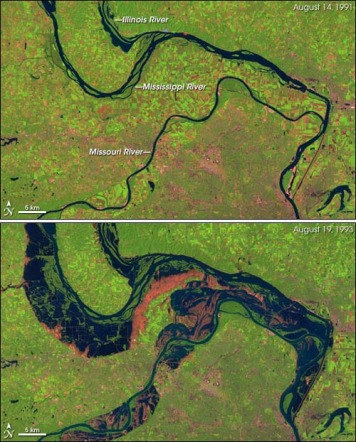Coastal Engineering - Amphibious Housing
The Great Flood of 1993

Credits: LandSat Observatory Team
The Great Flood of 1993 happened within the lifetime of most people living today and is regarded as one of the most overwhelming natural disasters in United States history. The flood occured throughout 200 days during the summer of 1993 as a result of above average rainfall throughout much of the midwest. Some counties experienced 30" of rainfall in one month and other areas received 10 inches of rain in as little as 4 hours. The rainfall amounts were between 250-300% of normal levels which led to record-breaking crest heights along many rivers.
During the course of the flood, 150 rivers flooded and 92 locations throughout the region set record crest levels. One of these was the Mississippi River in St. Louis, MO which peaked at 49.47 ft. Over 1,000 levees failed while 400,000 square miles were affected and 50 people perished. Upwards of 50,000 homes were destroyed amidst a damage total of $15 billion.
During the course of the flood, 150 rivers flooded and 92 locations throughout the region set record crest levels. One of these was the Mississippi River in St. Louis, MO which peaked at 49.47 ft. Over 1,000 levees failed while 400,000 square miles were affected and 50 people perished. Upwards of 50,000 homes were destroyed amidst a damage total of $15 billion.
Potential Application: Amphibious Houses

The hypothetical situation considered in this report is the following: How would the damage to residential homes have been different if amphibious homes with floating foundations would have been implemented? Using flood data from 29 locations throughout the flooded area, the potential cost-savings for three different design scenarios were calculated.
When considering this case, a few asuumptions were made. Firstly, it was assumed that 50,000 homes were flooded and that a full loss of value was epxerienced for each home. Using data of past homes, it was determined that the average cost for a home in 1993 was $113,200. Adjusted for inflation to 2008 dollars, this is $166,634. Another assumption was that the number of homes destroyed throughout the 29 locations was directly related to their population, meaning that a city with twice the population of another would have twice as many homes destroyed. This approach placed the majority of destroyed homes in two major cities: St Louis and Kansas City, MO. However, all 29 locations were still considered during calculations.
When considering this case, a few asuumptions were made. Firstly, it was assumed that 50,000 homes were flooded and that a full loss of value was epxerienced for each home. Using data of past homes, it was determined that the average cost for a home in 1993 was $113,200. Adjusted for inflation to 2008 dollars, this is $166,634. Another assumption was that the number of homes destroyed throughout the 29 locations was directly related to their population, meaning that a city with twice the population of another would have twice as many homes destroyed. This approach placed the majority of destroyed homes in two major cities: St Louis and Kansas City, MO. However, all 29 locations were still considered during calculations.
Cost Savings Analysis: Results
Although the numbers used are approximations, the cases show that in order to mitigate damages during large flood events an 18 ft or higher floating foundation would be advisable. If structurally and economically feasible, a 25 ft float would provide the most cost savings in a flood event.
- Case 1: 50% homes with 10 ft float
- 143 homes saved; $23 million in cost savings
- Case 2: 50% with 18 ft float
- 11,557 homes saved; $1,926 million in cost savings
- Case 3: 50% with 25 ft float
- 25,000 homes saved; $4,166 million in cost savings
| great_flood_damages_calculations.xls |
